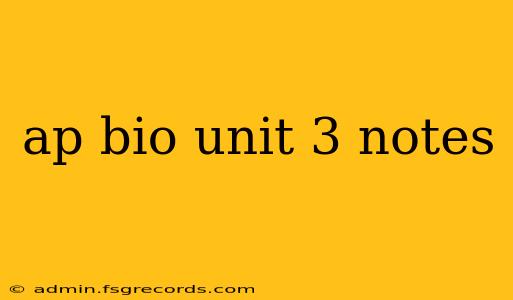Unit 3 of AP Biology delves into the fascinating world of cellular energetics, focusing on the processes cells use to harvest and utilize energy. This is a crucial unit, building upon previous knowledge of cell structure and function and laying the groundwork for future units on genetics and evolution. These notes provide a comprehensive overview, emphasizing key concepts and connections.
I. Introduction to Energy and Metabolism
- Energy: The capacity to cause change or do work. Cells require energy for various functions, including growth, reproduction, and maintaining homeostasis.
- Metabolism: The totality of an organism's chemical reactions. It's a highly organized and regulated process involving catabolic and anabolic pathways.
- Catabolic Pathways: Break down complex molecules into simpler ones, releasing energy (e.g., cellular respiration).
- Anabolic Pathways: Build complex molecules from simpler ones, requiring energy (e.g., protein synthesis).
- Thermodynamics: The study of energy transformations.
- First Law of Thermodynamics (Conservation of Energy): Energy cannot be created or destroyed, only transformed.
- Second Law of Thermodynamics: Every energy transfer increases the entropy (disorder) of the universe. Cells maintain order by constantly exchanging energy with their surroundings.
II. Enzymes and Activation Energy
- Enzymes: Biological catalysts that speed up chemical reactions by lowering the activation energy. They are highly specific and often require cofactors (inorganic) or coenzymes (organic) to function.
- Activation Energy: The initial energy input needed to start a reaction. Enzymes reduce this energy barrier, allowing reactions to proceed at a faster rate.
- Enzyme-Substrate Complex: The temporary binding of an enzyme to its substrate, forming an active site where the reaction occurs.
- Factors Affecting Enzyme Activity: Temperature, pH, substrate concentration, enzyme concentration, and inhibitors.
- Competitive Inhibitors: Bind to the active site, competing with the substrate.
- Noncompetitive Inhibitors: Bind to an allosteric site, changing the enzyme's shape and reducing its activity. Feedback inhibition is a common example.
III. Cellular Respiration: Harvesting Chemical Energy
-
Cellular Respiration: The process by which cells break down glucose to produce ATP (adenosine triphosphate), the cell's main energy currency. It's a catabolic pathway occurring in four main stages:
- Glycolysis: Occurs in the cytoplasm, yielding a small amount of ATP and NADH. It doesn't require oxygen (anaerobic).
- Pyruvate Oxidation: Occurs in the mitochondrial matrix, converting pyruvate to acetyl-CoA, releasing CO2 and producing NADH.
- Krebs Cycle (Citric Acid Cycle): Occurs in the mitochondrial matrix, completing the oxidation of glucose, producing ATP, NADH, FADH2, and releasing CO2.
- Oxidative Phosphorylation (Electron Transport Chain and Chemiosmosis): Occurs in the inner mitochondrial membrane, using the electron carriers (NADH and FADH2) to generate a proton gradient, which drives ATP synthesis via chemiosmosis. This is where the majority of ATP is produced.
-
ATP Synthesis: ATP synthase is a molecular machine that uses the proton gradient to phosphorylate ADP to ATP.
-
Fermentation: Anaerobic process used when oxygen is unavailable, producing less ATP than cellular respiration. Examples include lactic acid fermentation and alcoholic fermentation.
IV. Photosynthesis: Capturing Light Energy
-
Photosynthesis: The process by which plants and other organisms convert light energy into chemical energy in the form of glucose. It occurs in two main stages:
- Light-dependent reactions: Occur in the thylakoid membranes of chloroplasts, converting light energy into chemical energy in the form of ATP and NADPH. Water is split, releasing oxygen as a byproduct. This involves photosystems I and II and an electron transport chain.
- Light-independent reactions (Calvin Cycle): Occur in the stroma of chloroplasts, using ATP and NADPH from the light-dependent reactions to convert CO2 into glucose. This involves carbon fixation, reduction, and regeneration of the RuBP molecule.
-
Photosystems: Protein complexes containing chlorophyll and other pigments that absorb light energy.
-
Chlorophyll: The primary pigment in photosynthesis, absorbing red and blue light most effectively.
V. Connecting Cellular Respiration and Photosynthesis
Cellular respiration and photosynthesis are interconnected processes. The products of one are the reactants of the other, forming a cycle that sustains life on Earth. Photosynthesis captures light energy and converts it into chemical energy in the form of glucose, while cellular respiration releases the energy stored in glucose to produce ATP, the energy currency of cells. The oxygen produced by photosynthesis is used in cellular respiration, and the carbon dioxide produced by cellular respiration is used in photosynthesis.
This detailed outline provides a solid foundation for understanding cellular energetics in AP Biology. Remember to consult your textbook and class notes for further detail and specific examples. Practice applying these concepts through problems and diagrams to solidify your understanding. Good luck with your studies!

